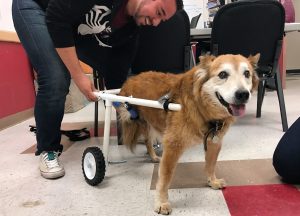By: Tiffany Acosta, 575-646-3929, tfrank@nmsu.edu
 |
|
| Arturo Dominguez, a New Mexico State University College of Engineering student, fits nearly 17-year-old Kita with a wheelchair that was designed and built in the Aggie Innovation Space. (Courtesy photo) DEC16 |
During the fall semester, three College of Engineering students working as on-campus co-ops at New Mexico State University designed and built a wheelchair device to assist a dog who had his right hind leg amputated due to cancer this past spring. Through the Aggie Innovation Space, Aggie Innovators Natalia Perez, Abdiel Jimenez and Arturo Dominguez designed and created a customized device for the almost 17-year-old Kita and his owner Michelle Lebsock.
“When I started to research mobility options to help Kita after his amputation to remove bone cancer, there were a lot of ideas online about using 3-D printers to create custom dog wheelchairs or walkers,” Lebsock said. “Even in his old age, Kita is the type of dog who absolutely loves walks, and although he healed well and adjusted to getting around on three legs, he would get tired very quickly and I could tell he really missed his long walks.”
After realizing regular pet wheelchairs wouldn’t work for Kita, Lebsock contacted the Aggie Innovation Space for advice on do-it-yourself dog wheelchair instructions she had found online.
“I first spoke to Natalia, and instead of just offering advice she took on the project as her own,” Lebsock said. “The talented engineering students at the AIS including Natalia, Abdiel and Arturo worked all semester to create a functional and ergonomic device that was custom-built for Kita. Even though the idea of 3-D printing brought me to the lab, the final product used traditional materials, and the students worked tirelessly to make sure each piece was exactly right. Their work has made one little three-legged dog and his owner very happy.”
“The AIS team became very passionate about this project sharing ideas, collaborating to assess specific constraints and requirements, and evaluating ideas for build-out materials. Collectively, we were able to design a device that was cost effective, functional, comfortable, strong enough to support the weight of the dog, and ultimately, easy to use,” Jimenez said. “We selected specific materials and specific design features to meet the unique needs of Kita. Michelle was kind enough to give us feedback, which allowed us to further refine the design.”
 |
|
| New Mexico State University College of Engineering students and Aggie Innovation Space mentors (from left to right) Natalia Perez, Abdiel Jimenez and Arturo Dominguez designed and developed a wheelchair for Kita and his owner Michelle Lebsock. Kita’s right hind leg was amputated due to cancer in spring 2016. (Courtesy photo) DEC16 |
Throughout the fall, Perez, Jimenez and Dominguez met with Kita and Lebsock many times to determine the correct height, comfort, and restraint requirements of the device. Ease of assembly and disassembly were also important factors the Aggie Innovators had to consider to ensure the device was portable and easy to use.
“We were excited to have met a functional level of comfort for Kita with our first design, as he realized he could move around freely,” Dominguez said. “From there, we studied and evaluated Kita’s movement in the device, which allowed us to adjust the design to make it more comfortable and functional. With each iteration, Kita became more and more comfortable. During our final test, Kita was able to run for the first time since surgery and was able to move much more naturally. We then spent a week enhancing a few aesthetic features and branded it NMSU, including a specialized 3-D printed name plate.”
Dominguez said the group faced many design challenges throughout the duration of this project.
“Some of our initial design considerations required us to adjust the height of the device while ensuring that we provided adequate support of the shoulders and hips so as to minimize weight on pressure points,” Dominguez said. “As we adjusted the saddle mechanism in the device, we had to be sure not to pinch or irritate the underbelly and other sensitive areas of the dog.”
Perez said the challenges and hours spent working on this project was worth it when she and her fellow Aggie Innovators saw Kita run freely in the device and saw the happiness expressed in Lebsock’s reaction.
“This project reminded us how engineers can enhance quality of life, and made us realize that our duty as engineers is not just for people and the environment but for our furry friends that make our lives happier,” Perez said.
